Educational program for electrical injuries: from burns and cataracts to fractures and atrial fibrillation
In the comments to our article about the death of a Malaysian schoolchild in headphones, we promised to make a post about electrical injuries, as well as about the features of the pathogenic effect of electric current on organs and tissues of the human body. Promised - execute.

The post was prepared jointly with dlinyj , who acted as a reviewer and consultant in matters of physics of electricity and labor protection, as well as a co-author of the section “What Kills Current or Voltage?”. Under the cat, I described in detail the mechanisms for obtaining electrical injuries, medical consequences, and also analyzed several tragic cases associated with unusual electrical injuries. In preparing the material, I used my own medical experience, facts known from the media, as well as online literature and documents (photos of lesions contained in the article, some readers may find shocking and unacceptable).
Let's start with this holivar-forming question, without which, perhaps, not a single popular post about electrical injury. Without much reasoning I will write - the main striking factor is the current, it is he who kills. As we all know from the school physics course, current = voltage / resistance. I believe that it is correct to say that voltage (potential difference) is a condition of defeat, but by itself does not cause damage.
For example, the voltage of static discharges at the time of removing a wool sweater reaches several kilovolts, while they do not cause any significant damage, as the current is meager. Therefore, in such cases, the voltage is compared with the height, which in itself does not lead to death and cannot be its cause, in contrast to the fact of the fall, in which height becomes a significant condition for the onset of death.
Today, in various literature there are a lot of classifications and definitions of a person's electric shock, they are all interesting, but they bring a lot of confusion. In my opinion, one should adhere to the generally accepted definition that is adopted in WHO.
Thus, according to the WHO standards, it is accepted to call an electric shock an electric shock (no impacts or other types of damage are singled out separately). According to the WHO standards, any injury is a physical damage to the organs and tissues caused by this or that type of energy. Therefore, electrical injury - any damage (disruption of activity) caused by exposure to current, that is to say, electrical energy.
Types of exposure to current
There are three types of effects of electric current on the body, which fall under the definition of electrical injury:
Electric current can affect all tissues and organs without exception. Primarily affected skin, peripheral and central nervous system, muscles, tendons, cardiovascular system. Beats on bones, joints, digestive tract organs less often, but if it hits, it is strong, almost certainly.
The severity of the lesion
So, we list the factors that affect the severity of the electric shock :
Body Resistance Body
resistance is perhaps one of the most important and most difficult factors. It is variable and depends on complex biochemical and biophysical features, properties of tissues at the current point in time, features of the environment. In other words, this is one of the factors that makes any prediction of an electric shock (with a known magnitude) comparable in accuracy to the theological treatises of the 14th century or Nostradamus predictions.
The table below presents the resistance ranges of the tissues of our body, it is easy to understand from it that the values vary within very wide limits.

Classification of currents by type of impact.
The magnitude of the striking current is conventionally divided into 3 ranges, depending on what effect the current has. Thus, emit currents:
* Sometimes additionally emit so-called “Thermal" or "thermal" - low direct currents (from 5 A), causing a sensation of heat, burning.

The table below relates the ranges of AC and DC values and the lesions they are capable of causing (given, according to the manual by associate professor of the Department of Environmental Engineering and Labor Protection of the Moscow Power Engineering Institute,
SG Novikov).
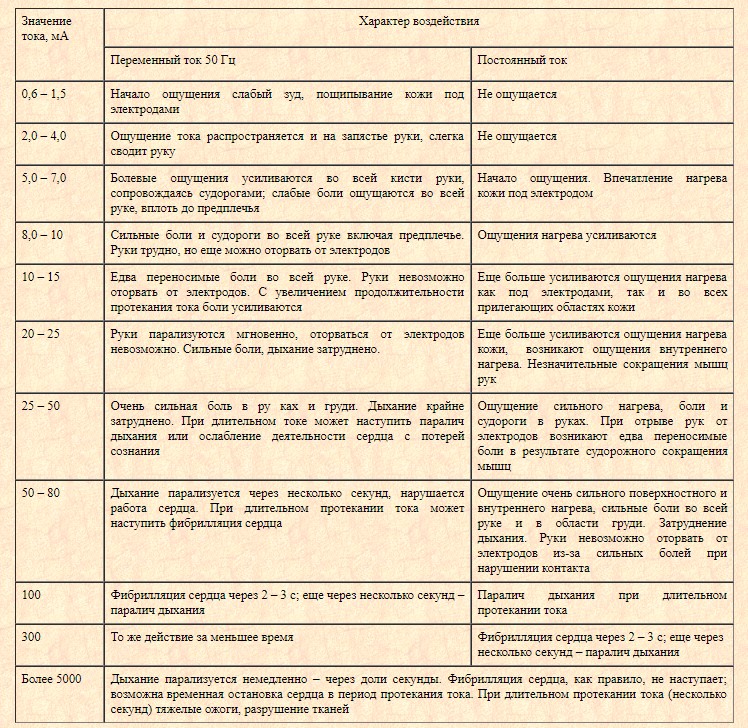
Paths of current
Another important and often decisive factor is the path of current, which depends on the points of entry and exit of the discharge. The most dangerous ways are those that pass through vital organs (brain and spinal cord, heart, lungs, liver, kidneys). Characteristic cases of electric shock through the headphones, when the current path flows through the head (in almost all known incidents ended in death).

If the path of the current does not pass through the vital organs, then the effect on them is exclusively reflexive, and accordingly, the danger to vital functions is much less. Paths of current through the human body are sometimes called loops. The most dangerous of them are: “hand-hand” (40% of deaths), “head-legs” and “head-hand” (together about 20%), “right hand - legs” (20%), “left hand “legs” (17%), other deaths are approximately 3%.
In the table below, the percentage ratio of the striking electrical current passing through the heart is indicated for various current paths:

A bit about the mechanism of tissue damage
According to Ilisheva, after the current overcomes the resistance of the skin, it penetrates the tissue and causes electrolysis, which, in turn, leads to an imbalance in the cell formations. The rapid tissue necrosis in electric shock is caused just by the polarization of cell membranes during electrolysis. The following happens:
These processes of ion concentration change the state of the cells and lead to coagulation necrosis in areas with an acid reaction and collicquation in areas with alkaline.
Under the action of the current on the nerve fibers, perineural edema, necrosis (necrosis) of neuronal structures, and thrombosis of the surrounding vessels are noted. Similar processes occur in muscle tissue. Before the development of necrosis, nervous tissue is irritated, and in muscles there is a tone and convulsive contractions, which in turn lead to mechanical damage (see below).
The skin is mainly affected at the points of charge input and output, thermal phenomena can cause burns and blotches of foreign metallic particles (see below), and the electrochemical effect of the current causes changes in the color of the skin (see current marks).
Some authors distinguish three types of electrical injuries, namely local, general and mixed. Burns, electrical signs (marks), skin metallization and mechanical damage are considered local. Common are such lesions with electric shock, in which common symptoms are expressed, in the form of lesions of the central nervous and cardiovascular systems. Mixed have signs of both local and common.
In fact, this division is very conditional. Most often there are mixed electrical shock. Their percentage is significantly higher than 50% claimed in some labor safety benefits, which people who apparently did not deal with electrical injuries in practice wrote. For 9 years in disaster medicine, I happened to face only a mixed type. I believe that this happens due to the fact that an electric shock that can cause local damage will surely lead to the development of common symptoms along with it. Therefore, I believe, it is more correct to speak of local and general manifestations of electrical injury, but not of local and general electrical injuries.
Electric burns
Among the local manifestations are more common so-called. electric burns, which are divided into contact and arc. I write “so-called”, due to the fact that a burn is caused by a high temperature of a conductor or an electric arc flame, i.e. in fact, it is thermal, but is burdened by other damaging factors of electrical injury.
Contact develops with direct contact of the skin with the surface of the conductor, where due to the high current density and resistance of the skin, the temperature rises locally. They are characterized by a relatively small area of damage (as a rule, 1% of skin or less) with different depth of damage and severity of the condition.
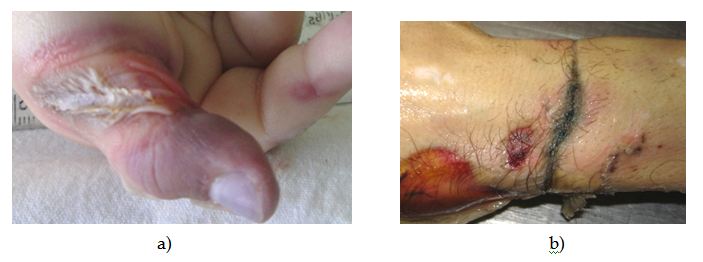
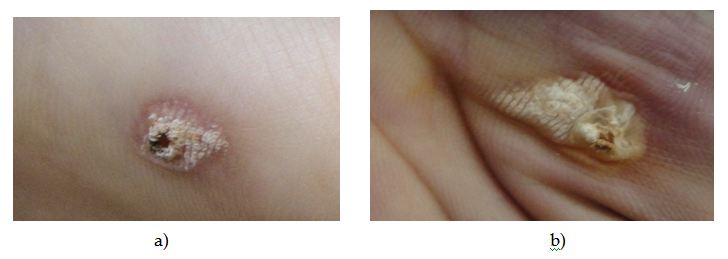
Contact electric burns
Arcuate, often heavier, often accompanied by an extensive 50% or more, and deep (up to 4 degrees) lesions. This is due to a higher temperature, and also, often, to a higher lesion area. Arc burns are more likely to cause burn shock and burn disease. In cases of electric shock from gadgets and household appliances - arc burns are not so brutal, as the arc is often small, and accordingly the damage area is smaller.

Arc electric
burners. Current
labels. Tags (they are also signs) are oval gray or yellowish spots with a small depression in the center. Signs can appear immediately or over time, there are cases when they disappeared without a trace. This symptom is often found with severe general symptoms in the places of entry and exit of charge. Does not require special assistance, but can be used as a valuable diagnostic feature.
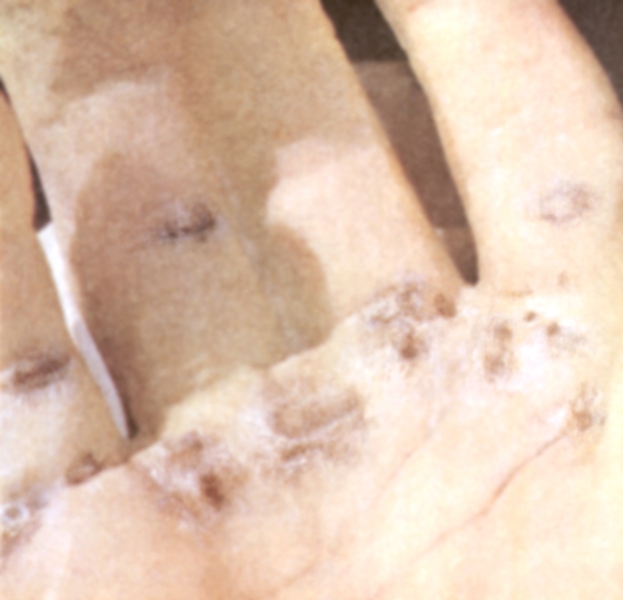 Current labels on the palm
Current labels on the palm

Current marks after a lightning strike.
Metallization
Metallization is the intradermal (deep skin) penetration of small metal particles that have melted under the action of electric arcs. The metal heated by the arc, damaging the upper layers of the skin, cools quickly, transferring heat to very warm skin and solidifies in a thermocoagulated burn surface (in a scab).

metallization
With minor, shallow (before the growth layer of the skin) skin lesions, metallization can disappear without a trace, as well as pain associated with it, but more often these lesions are deeper and leave scars.
Eye
injuries Especially dangerous is the cornea metallization. Such a lesion leads to a temporary, in need of long-term treatment, and sometimes incurable blindness. From the local ophthalmic manifestations, you can also select the clouding of the lens (cataract), which sometimes occurs when the discharge passes through the head.
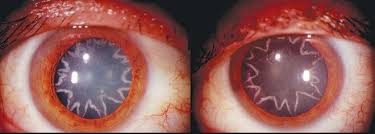
Stellar stellate cataract after electrical
injury Fractures and other mechanical injuries
Interestingly, an electrical injury can lead to severe mechanical injuries, such as sprains, torn ligaments, fractures, and also cause bleeding from damaged vessels. The main cause of such damage are considered convulsions that have developed as a result of the irritating effects of the current.
So, the Malaysian schoolboy, about whom we wrote, there was a bleeding in places of skin contact with headphones.
 Bleeding from the ear, after an electric shock through the headphones
Bleeding from the ear, after an electric shock through the headphones
In 2017, a case of fractures of the forearm bones in a child as a result of an electric shock was recorded in Pervouralsk . For mechanical damage due to electric shock, it is not customary to attribute injuries received indirectly, for example, when falling after receiving an electric shock.
Common manifestations
The general effect of the current leads to disruption of the work of vital organs and systems; the current is capable of affecting all organs and tissues of a person. Depending on the factors described above, the effect may be completely different in the severity and severity of the clinic.
There are 4 severity of electric shock:
* Clinical death - lack of breathing, cardiac activity, consciousness.
* Fibrillation - a disorderly contraction of the heart chambers.
The widespread distribution of gadgets has led to a noticeable increase in the number of electrical injuries received in everyday life. It is quite natural that all of them are caused by gadgets charging from the network, and, often, in situations where the user carelessly ignores the electrical safety rules. There is much in common between such cases. Conducting a small content analysis of cases over the past 8 years, I noticed that most occur in developing countries with a hot humid climate (China, India, Malaysia, Brazil).
In the overwhelming majority of cases, the cause of the damage is a gadget that charges from a low-quality charger with a problem galvanic isolation. In these countries, frame housing construction with metal support structures is widespread, to which floor coverings are attached with the help of conductive elements. In total, I counted 42 cases of this kind of electrical injury. Regions with a hot climate, relatively low living standards and cheap frame houses belonged to 36.
Below I will cite only the most well-known and loud incidents, I will not hide that while making this sample, I tried to give examples close to the case in Malaysia (headphones + smartphone + charging ), in order to demonstrate not one and one hundred percent mortality:
Malaysian incident, 2018. Teenager, headphones, charging smartphone.
Brazil, 2018. The case of a girl and headphones (possibly affected by lightning)
India, 2018. Headphone electrical shock (female, 46 years old.
India, 2018. Headphone electrical shock (Tad Singh, 22-year-old man)
Electric shock when the smartphone is disconnected from USB cable. Internet cafe case in Wuhan, China - 2016, (teenager, Internet cafe, smartphone, PC).
Malaysia 2017. Case with a smartphone connected to the outlet.
London. Electric shock from a charging smartphone in the bathroom (male, 32 years old )
China. Coma due to electric shock - 2013, charging smartphone.
China, 2017. Girl -p One teenager, 14 years old, damaged smartphone charger USB cable.
Once again, all cases of electrical shock known to me through headphones are lethal, which confirms the danger of head-limb loops.
One of the situations described above was recorded on video in China in 2016. By disconnecting the smartphone from the PC, the gamer received a deadly discharge. There I was particularly struck by the behavior of others who practically did not provide assistance.
The video is not recommended for viewing by children and impressionable.
In all cases except Brazil (where the lightning strike probably took place), there was grounding (through baths, flooring elements, grounded metal table).
Anyway, all such cases fit into the existing ideas about electrical injuries and confirm many of the above. With a detailed analysis, apparent paradoxes turn into quite ordinary history for burn centers, resuscitation departments and pathoanatomical bureaus.
I sincerely hope that the presented educational program was useful. We would appreciate if you share your opinions in the comments. Perhaps you have experienced electric shock or its consequences, or you regularly encounter this at work, tell others about your experience. Perhaps there will be another post related to first aid - write if this is relevant to you. Photo
content used:
steemit.com/comedy/@grow-pro/finding-my-funny-ass-underwater-flooding-and-funny-gifs-w-grow-pro
www.intechopen.com/books/forensic-medicine-from -old-problems-to-new-challenges / epidemiology-and-diagnostic-problems-of-electrical-injury-in-forensic-medicine
cdn.intechweb.org/pdfs/19164.pdf
accessmedicine.mhmedical.com/content.aspx ? bookid = 1763 & sectionid = 125437574 & jumpsectionid = 125437642
vpr.sdamgia.ru/problem?id=807
ppt-online.org/44358
Advertising load
We sell electronics, different, a lot. If you follow the rules of operation, the electronics we sell does not cause an electric shock. Moreover, we do not know of a single case when our customers would receive an electric shock from the goods purchased from us.

The post was prepared jointly with dlinyj , who acted as a reviewer and consultant in matters of physics of electricity and labor protection, as well as a co-author of the section “What Kills Current or Voltage?”. Under the cat, I described in detail the mechanisms for obtaining electrical injuries, medical consequences, and also analyzed several tragic cases associated with unusual electrical injuries. In preparing the material, I used my own medical experience, facts known from the media, as well as online literature and documents (photos of lesions contained in the article, some readers may find shocking and unacceptable).
Warning from moderator. The publication contains images of the parts of the body of injured people, which can affect the mental state of sensitive adults and children.
What kills: current or voltage?
Let's start with this holivar-forming question, without which, perhaps, not a single popular post about electrical injury. Without much reasoning I will write - the main striking factor is the current, it is he who kills. As we all know from the school physics course, current = voltage / resistance. I believe that it is correct to say that voltage (potential difference) is a condition of defeat, but by itself does not cause damage.
For example, the voltage of static discharges at the time of removing a wool sweater reaches several kilovolts, while they do not cause any significant damage, as the current is meager. Therefore, in such cases, the voltage is compared with the height, which in itself does not lead to death and cannot be its cause, in contrast to the fact of the fall, in which height becomes a significant condition for the onset of death.
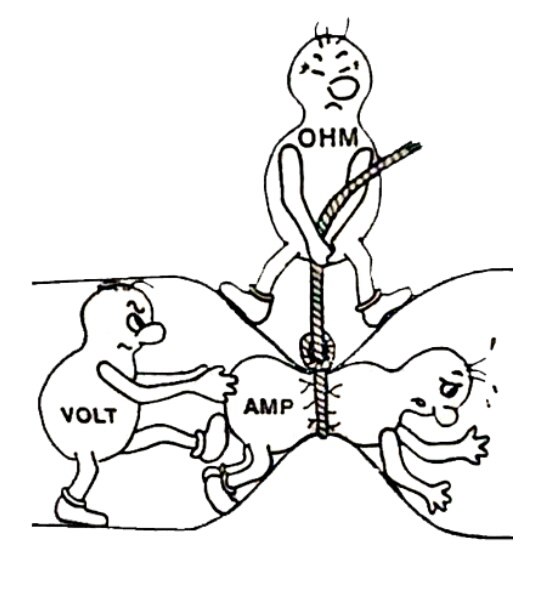
It should be remembered that such an electric current. As follows from the Russian name, the current is a current, that is, the flow of charged particles. What is the number of flows per unit of time through the unit section of the conductor. The greater the number of particles, the greater the current. It is the flow of particles that is the cause of human damage. The amount of current that can pass through a person is determined by the applied voltage, the internal resistance of the current source and the resistance of the human body.
As a rule, current sources (and voltages) have an output current several orders of magnitude greater than lethal to humans, and in this case, the determining factor in the magnitude of the current is the resistance of the human body and the magnitude of the applied voltage. The resistance of the human body depends on the individual characteristics of the person and his physical condition. For example, a sweaty person has a very low resistivity, and there have been cases when a person was killed by the voltage on the contacts of a regular battery. dlinyj
Electrical injury according to WHO standards, tissue processes and severity of injury
Today, in various literature there are a lot of classifications and definitions of a person's electric shock, they are all interesting, but they bring a lot of confusion. In my opinion, one should adhere to the generally accepted definition that is adopted in WHO.
Thus, according to the WHO standards, it is accepted to call an electric shock an electric shock (no impacts or other types of damage are singled out separately). According to the WHO standards, any injury is a physical damage to the organs and tissues caused by this or that type of energy. Therefore, electrical injury - any damage (disruption of activity) caused by exposure to current, that is to say, electrical energy.
Types of exposure to current
There are three types of effects of electric current on the body, which fall under the definition of electrical injury:
- biological - irritation and excitation of muscle and nerve fibers, violation of bioelectric processes;
- thermal - burns and heating of tissues under the action of current;
- electrolytic - changes in the physicochemical composition and properties of biological fluids (blood, lymph, cerebrospinal fluid, etc.).
Electric current can affect all tissues and organs without exception. Primarily affected skin, peripheral and central nervous system, muscles, tendons, cardiovascular system. Beats on bones, joints, digestive tract organs less often, but if it hits, it is strong, almost certainly.
The severity of the lesion
So, we list the factors that affect the severity of the electric shock :
- current path, location of the lesion;
- the magnitude of the striking current (A);
- current type (AC or DC);
- current frequency (Hz);
- body resistance (ohms);
- humidity and temperature of the air (with an increase in temperature, perspiration begins, which reduces body resistance);
- the condition of the skin (the presence of wounds, skin diseases, sweat, etc.);
- Also, when assessing, stress is taken into account, but contrary to the established stereotype, it does not have a decisive meaning.
Body Resistance Body
resistance is perhaps one of the most important and most difficult factors. It is variable and depends on complex biochemical and biophysical features, properties of tissues at the current point in time, features of the environment. In other words, this is one of the factors that makes any prediction of an electric shock (with a known magnitude) comparable in accuracy to the theological treatises of the 14th century or Nostradamus predictions.
The table below presents the resistance ranges of the tissues of our body, it is easy to understand from it that the values vary within very wide limits.

Classification of currents by type of impact.
The magnitude of the striking current is conventionally divided into 3 ranges, depending on what effect the current has. Thus, emit currents:
- non-sensible - from 0.5 - 1.5 mA;
- sensible - 3 mA - the impact of current is felt tactile;
- letting go - 6 mA - causes muscle spasm, with it clutching the conductor, the affected can release it;
- non-releasing - from 10 to 15 mA - the affected cannot release the conductor without assistance;
- suffocating from 25 to 50 mA - can cause paralysis of the respiratory center;
- fibrillation from 100 to 200 mA - causing fibrillation (irregular contraction) of the heart chambers - one of the types of cardiac arrest .;
* Sometimes additionally emit so-called “Thermal" or "thermal" - low direct currents (from 5 A), causing a sensation of heat, burning.

The table below relates the ranges of AC and DC values and the lesions they are capable of causing (given, according to the manual by associate professor of the Department of Environmental Engineering and Labor Protection of the Moscow Power Engineering Institute,
SG Novikov).

Paths of current
Another important and often decisive factor is the path of current, which depends on the points of entry and exit of the discharge. The most dangerous ways are those that pass through vital organs (brain and spinal cord, heart, lungs, liver, kidneys). Characteristic cases of electric shock through the headphones, when the current path flows through the head (in almost all known incidents ended in death).

If the path of the current does not pass through the vital organs, then the effect on them is exclusively reflexive, and accordingly, the danger to vital functions is much less. Paths of current through the human body are sometimes called loops. The most dangerous of them are: “hand-hand” (40% of deaths), “head-legs” and “head-hand” (together about 20%), “right hand - legs” (20%), “left hand “legs” (17%), other deaths are approximately 3%.
In the table below, the percentage ratio of the striking electrical current passing through the heart is indicated for various current paths:

A bit about the mechanism of tissue damage
According to Ilisheva, after the current overcomes the resistance of the skin, it penetrates the tissue and causes electrolysis, which, in turn, leads to an imbalance in the cell formations. The rapid tissue necrosis in electric shock is caused just by the polarization of cell membranes during electrolysis. The following happens:
- at the anode, ions with a positive charge are concentrated, the medium becomes acidic;
- a cathode accumulates negatively charged ions, which triggers an alkaline reaction.
These processes of ion concentration change the state of the cells and lead to coagulation necrosis in areas with an acid reaction and collicquation in areas with alkaline.
Under the action of the current on the nerve fibers, perineural edema, necrosis (necrosis) of neuronal structures, and thrombosis of the surrounding vessels are noted. Similar processes occur in muscle tissue. Before the development of necrosis, nervous tissue is irritated, and in muscles there is a tone and convulsive contractions, which in turn lead to mechanical damage (see below).
The skin is mainly affected at the points of charge input and output, thermal phenomena can cause burns and blotches of foreign metallic particles (see below), and the electrochemical effect of the current causes changes in the color of the skin (see current marks).
Types of electric shock
Some authors distinguish three types of electrical injuries, namely local, general and mixed. Burns, electrical signs (marks), skin metallization and mechanical damage are considered local. Common are such lesions with electric shock, in which common symptoms are expressed, in the form of lesions of the central nervous and cardiovascular systems. Mixed have signs of both local and common.
In fact, this division is very conditional. Most often there are mixed electrical shock. Their percentage is significantly higher than 50% claimed in some labor safety benefits, which people who apparently did not deal with electrical injuries in practice wrote. For 9 years in disaster medicine, I happened to face only a mixed type. I believe that this happens due to the fact that an electric shock that can cause local damage will surely lead to the development of common symptoms along with it. Therefore, I believe, it is more correct to speak of local and general manifestations of electrical injury, but not of local and general electrical injuries.
Electric burns
Among the local manifestations are more common so-called. electric burns, which are divided into contact and arc. I write “so-called”, due to the fact that a burn is caused by a high temperature of a conductor or an electric arc flame, i.e. in fact, it is thermal, but is burdened by other damaging factors of electrical injury.
Contact develops with direct contact of the skin with the surface of the conductor, where due to the high current density and resistance of the skin, the temperature rises locally. They are characterized by a relatively small area of damage (as a rule, 1% of skin or less) with different depth of damage and severity of the condition.


Contact electric burns
Arcuate, often heavier, often accompanied by an extensive 50% or more, and deep (up to 4 degrees) lesions. This is due to a higher temperature, and also, often, to a higher lesion area. Arc burns are more likely to cause burn shock and burn disease. In cases of electric shock from gadgets and household appliances - arc burns are not so brutal, as the arc is often small, and accordingly the damage area is smaller.

Arc electric
burners. Current
labels. Tags (they are also signs) are oval gray or yellowish spots with a small depression in the center. Signs can appear immediately or over time, there are cases when they disappeared without a trace. This symptom is often found with severe general symptoms in the places of entry and exit of charge. Does not require special assistance, but can be used as a valuable diagnostic feature.


Current marks after a lightning strike.
Metallization
Metallization is the intradermal (deep skin) penetration of small metal particles that have melted under the action of electric arcs. The metal heated by the arc, damaging the upper layers of the skin, cools quickly, transferring heat to very warm skin and solidifies in a thermocoagulated burn surface (in a scab).

metallization
With minor, shallow (before the growth layer of the skin) skin lesions, metallization can disappear without a trace, as well as pain associated with it, but more often these lesions are deeper and leave scars.
Eye
injuries Especially dangerous is the cornea metallization. Such a lesion leads to a temporary, in need of long-term treatment, and sometimes incurable blindness. From the local ophthalmic manifestations, you can also select the clouding of the lens (cataract), which sometimes occurs when the discharge passes through the head.

Stellar stellate cataract after electrical
injury Fractures and other mechanical injuries
Interestingly, an electrical injury can lead to severe mechanical injuries, such as sprains, torn ligaments, fractures, and also cause bleeding from damaged vessels. The main cause of such damage are considered convulsions that have developed as a result of the irritating effects of the current.
So, the Malaysian schoolboy, about whom we wrote, there was a bleeding in places of skin contact with headphones.

In 2017, a case of fractures of the forearm bones in a child as a result of an electric shock was recorded in Pervouralsk . For mechanical damage due to electric shock, it is not customary to attribute injuries received indirectly, for example, when falling after receiving an electric shock.
Common manifestations
The general effect of the current leads to disruption of the work of vital organs and systems; the current is capable of affecting all organs and tissues of a person. Depending on the factors described above, the effect may be completely different in the severity and severity of the clinic.
There are 4 severity of electric shock:
- 1st — convulsions with preserved consciousness;
- 2nd — convulsions with loss of consciousness, but without disturbances in breathing and blood circulation;
- 3rd - convulsions in combination with loss of consciousness, as well as respiratory disorders (tachypnea, dyspnea) and (or) cardiac activity (arrhythmia, tachycardia);
- 4th - clinical death, usually resulting from fibrillation or lesion of the respiratory center (located in the medulla).
* Clinical death - lack of breathing, cardiac activity, consciousness.
* Fibrillation - a disorderly contraction of the heart chambers.
Gadgets and electrical injuries
The widespread distribution of gadgets has led to a noticeable increase in the number of electrical injuries received in everyday life. It is quite natural that all of them are caused by gadgets charging from the network, and, often, in situations where the user carelessly ignores the electrical safety rules. There is much in common between such cases. Conducting a small content analysis of cases over the past 8 years, I noticed that most occur in developing countries with a hot humid climate (China, India, Malaysia, Brazil).
In the overwhelming majority of cases, the cause of the damage is a gadget that charges from a low-quality charger with a problem galvanic isolation. In these countries, frame housing construction with metal support structures is widespread, to which floor coverings are attached with the help of conductive elements. In total, I counted 42 cases of this kind of electrical injury. Regions with a hot climate, relatively low living standards and cheap frame houses belonged to 36.
Below I will cite only the most well-known and loud incidents, I will not hide that while making this sample, I tried to give examples close to the case in Malaysia (headphones + smartphone + charging ), in order to demonstrate not one and one hundred percent mortality:
Malaysian incident, 2018. Teenager, headphones, charging smartphone.
Brazil, 2018. The case of a girl and headphones (possibly affected by lightning)
India, 2018. Headphone electrical shock (female, 46 years old.
India, 2018. Headphone electrical shock (Tad Singh, 22-year-old man)
Electric shock when the smartphone is disconnected from USB cable. Internet cafe case in Wuhan, China - 2016, (teenager, Internet cafe, smartphone, PC).
Malaysia 2017. Case with a smartphone connected to the outlet.
London. Electric shock from a charging smartphone in the bathroom (male, 32 years old )
China. Coma due to electric shock - 2013, charging smartphone.
China, 2017. Girl -p One teenager, 14 years old, damaged smartphone charger USB cable.
Once again, all cases of electrical shock known to me through headphones are lethal, which confirms the danger of head-limb loops.
One of the situations described above was recorded on video in China in 2016. By disconnecting the smartphone from the PC, the gamer received a deadly discharge. There I was particularly struck by the behavior of others who practically did not provide assistance.
The video is not recommended for viewing by children and impressionable.
In all cases except Brazil (where the lightning strike probably took place), there was grounding (through baths, flooring elements, grounded metal table).
Anyway, all such cases fit into the existing ideas about electrical injuries and confirm many of the above. With a detailed analysis, apparent paradoxes turn into quite ordinary history for burn centers, resuscitation departments and pathoanatomical bureaus.
Total
I sincerely hope that the presented educational program was useful. We would appreciate if you share your opinions in the comments. Perhaps you have experienced electric shock or its consequences, or you regularly encounter this at work, tell others about your experience. Perhaps there will be another post related to first aid - write if this is relevant to you. Photo
content used:
steemit.com/comedy/@grow-pro/finding-my-funny-ass-underwater-flooding-and-funny-gifs-w-grow-pro
www.intechopen.com/books/forensic-medicine-from -old-problems-to-new-challenges / epidemiology-and-diagnostic-problems-of-electrical-injury-in-forensic-medicine
cdn.intechweb.org/pdfs/19164.pdf
accessmedicine.mhmedical.com/content.aspx ? bookid = 1763 & sectionid = 125437574 & jumpsectionid = 125437642
vpr.sdamgia.ru/problem?id=807
ppt-online.org/44358
Advertising load
We sell electronics, different, a lot. If you follow the rules of operation, the electronics we sell does not cause an electric shock. Moreover, we do not know of a single case when our customers would receive an electric shock from the goods purchased from us.
